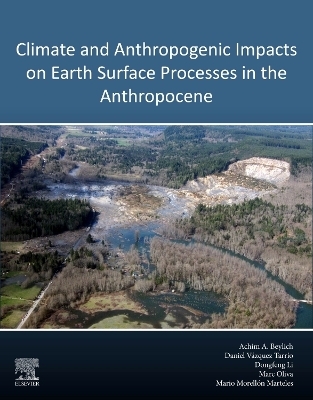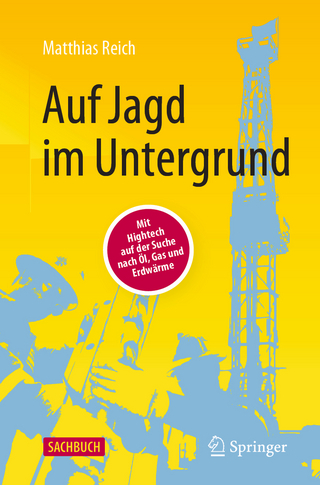
Climate and Anthropogenic Impacts on Earth Surface Processes in the Anthropocene
Elsevier - Health Sciences Division (Verlag)
978-0-443-13215-5 (ISBN)
This book is a valuable resource for upper-level undergraduates, graduates, and academics studying Earth surface processes, as well as researchers and professionals in needing a comprehensive overview of Earth surface process change and influence during the Anthropocene
Dr. Achim A. Beylich is a geomorphologist with more than 26 years of work experience in field- and laboratory based quantitative process geomorphic research in various climatic environments and landscapes in Iceland, Sweden, Finland, Canada, Russia, Germany, Austria, Norway and Spain. Since 2004, he has been initiating and leading a number of large international and interdisciplinary research networks and programmes on geomorphologic earth surface processes, denudation, sedimentary source-to-sink fluxes and correlations, sedimentary budgets, and landscape evolution under ongoing or accelerated climate change and increasing anthropogenic impacts and pressures. During his scientific career he has been working and has carried out research and training activities at various research institutes and universities in Germany, Sweden, Iceland, Canada and Norway. Since March 2018, he has been Head of Operations of the Geomorphological Field Laboratory (GFL), with offices in Selbu (Trondheim, Norway) (main office) and Calpe (Alicante, Spain). In this role, he is currently both leading and participating in a number of national and international scientific initiatives and research projects related to the analysis of contemporary earth surface systems and processes, hazardous processes, and landscape evolution under ongoing or accelerated environmental change. The various field study areas in different countries include both undisturbed and anthropogenically modified landscape systems. He is a research scientist with formal Professor rank in geomorphology and with more than 110 scientific publications in journals and books and numerous edited works. He is Editor-in-Chief for the journal Geomorphology (Elsevier), Associate Editor for the journal Global and Earth Surface Processes Change (Elsevier), Topical Editor for the journal Earth System Science Data (ESSD) (Copernicus), and an Editorial Board Member for several other international scientific journals. He was the initiator and Chair of the International Association of Geomorphologists (IAG) Working Group SEDIBUD (Sediment Budgets in Cold Environments, 2005-2017) and he has been the Chair (2017-2022) and a Steering Committee Member (2022-2026) for the IAG Working Group DENUCHANGE (Denudation and Environmental Changes in Different Morphoclimatic Zones). He was the founder and Chair of GeoNor, the IAG National Scientific Member (NSM) Norway (09/2019-01/2023), and he is the initiator and Chair of the IAG Nordic Network of Geomorphology Groups from Norway, Sweden, Finland, Denmark and Iceland (IAG NSM GeoNorth, Nordic Group Member and IAG Network, since 2019). Since September 2022, he is the elected Secretary-General of the International Association of Geomorphologists (IAG). Daniel Vázquez Tarrío holds a PhD in Geology from the University of Oviedo and currently works as Staff Researcher at Geological and Mining Institute of Spain (IGME, CSIC). Previously, he was an Assistant Lecturer at the Polytechnic University of Madrid. He is a fluvial geomorphologist specialized in the study of river hydraulics, sediment transport and morphodynamics of gravel-bed rivers. His approach to these questions involves coupling the field monitoring of these processes with the computation and modelling of water and sediment flows. He has also worked extensively on the impact of human interventions (dams and embankments) and land-use changes on sediment balances and flood-hazards in river systems. Daniel Vázquez Tarrío has investigated in these topics within the framework of several research projects focused in many rivers from Spain and France. Dr. Dongfeng Li is an Assistant Professor at the College of Environmental Sciences and Engineering, Peking University. He is leading the Cryosphere and River Lab. He is broadly interested in climate change, glaciers, permafrost, rivers, sediment transport, and hydropower dams. His current research focuses on sediment transport processes within the Earth’s cold environments, specifically driven by atmospheric, cryospheric, and hydrologic processes using remote sensing data and techniques, in-situ and field measurements, and numerical modeling approaches. During his PhD, he for the first time assessed the impacts of modern climate change on fluvial sediment fluxes in High Mountain Asia, for which he was awarded the 2019 IPCC Scholarship Award and the 2023 Grove Karl Gilbert Award of the American Association of Geographers. He is also the co-founder of the Chinese Geomorphology Club for early-career scientists and a core-member of the DENUCHANGE working group under the International Association of Geomorphologists. He serves as the associate editor of JGR: Earth Surface, editorial board of the Hydrological Processes, guest editors of Geomorphology and Earth Surface Processes and Landforms. Marc Oliva holds a PhD in Geography from the Universitat de Barcelona, where he works now as research scientist and leads a research group on Antarctic, Arctic and Alpine Environments. He has carried out research and teaching activities in universities of Portugal, Canada, Switzerland, Spain and Russia. He has participated in tens of expeditions to Antarctica and the High Arctic. Apart from the Polar Regions, he has also conducted research in other mountain regions (Rocky Mountains, Alps, N Iceland, Pamir, Tien Shan, Pyrenees, and Cantabrian Mountains), which has provided him a wide comprehension of Earth surface processes in cold-climate environments. His research interests include the study of geomorphological processes and past environments and climate in the Polar Regions and high mountains using a wide range of natural records (glacial, periglacial, and lacustrine). Mario Morellón Marteles is an assistant professor in Geology at the Complutense University of Madrid, Spain. His research has been focused on the reconstruction of past environmental changes based on the multidisciplinary analysis of lake sediments from key areas (Mediterranean Basin, South America, and Tibet) influenced by the main modes of climate variability (North Atlantic Oscillation, El Niño–Southern Oscillation and Indian Summer Monsoon) and/or different human impacts, from the late Pleistocene to the Anthropocene. His approach is based on geophysical, sedimentological and geochemical proxies but integrates biological indicators as well. During his career in Spain, United Kingdom and Switzerland, M. Morellón has led and participated in several projects and scientific initiatives aimed to disentangle the relative contributions of human activities and climate variability on recent environmental change, integrating different natural archives and proxies.
Block 1 Changing Earth Surface Processes
Section 1 Introduction
1. Global environmental change: from past to present
2. Drivers of earth surface processes
3. The Anthropocene
Section 2 Detection and quantification of Earth surface processes
4. Sedimentary records of Global Environmental Change
5. Landform record
6. Dating techniques
7. Remote sensing
8. Process monitoring
9. Conclusive remarks about technical issues and improvements on the identification of ‘Global environmental change’
Block 2 Climatic and anthropogenic drivers of earth surface processes
Section 3 Climate impacts on earth surface processes
10. Glacial and periglacial processes
11. Hillslope and mass-wasting processes
12. Fluvial processes
13. Aeolian processes
14. Estuaries and deltas
15. Coastal processes (cliffs, beaches, barriers, coastal dunes…), and wetlands
16. Karst processes
17. Considerations on the inherent complexities of disentangling anthropogenic and natural signals in landscape changes
Section 4 Anthropogenic impacts on earth surface processes
18. Glacial and periglacial processes
19. Hillslope and mass-wasting processes
20. Fluvial processes
21. Aeolian processes
22. Estuaries and deltas
23. Coastal processes (cliffs, beaches, barriers, coastal dunes…), and wetlands
24. Karst processes
25. Conclusive remarks highlighting key global problems
Block 3 The temporal and spatial scales
Section 5 The (relative) role of climate and anthropogenic impacts on earth surface processes
26. Through the Anthropocene: Sediment-routing at the global scale in the Anthropocene / The sediment cascade in the Anthropocene
27. Today
28. Future outlook, prediction, modelling
Section 6 Suggestions for adapted and sustainable mitigation and management strategies
29. (Sub)polar regions
30. Mountain areas
31. Karst environments
32. River systems (river restoration/rehabilitation)
33. Estuaries and deltas
34. Beaches, dunes and coastal areas, and wetlands
35. Arid environments (deserts)
36. Conclusive remarks disentangling climatic from anthropic signals in earth surface processes and highlighting future strategies
| Erscheinungsdatum | 02.10.2024 |
|---|---|
| Verlagsort | Philadelphia |
| Sprache | englisch |
| Maße | 216 x 276 mm |
| Gewicht | 450 g |
| Themenwelt | Naturwissenschaften ► Geowissenschaften ► Geologie |
| ISBN-10 | 0-443-13215-1 / 0443132151 |
| ISBN-13 | 978-0-443-13215-5 / 9780443132155 |
| Zustand | Neuware |
| Informationen gemäß Produktsicherheitsverordnung (GPSR) | |
| Haben Sie eine Frage zum Produkt? |
aus dem Bereich


